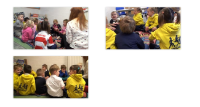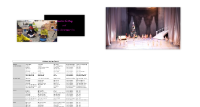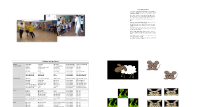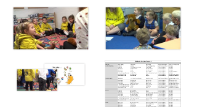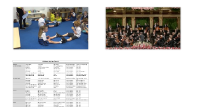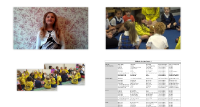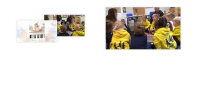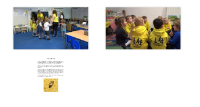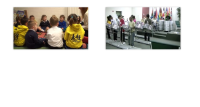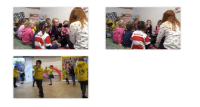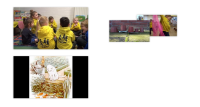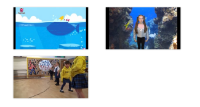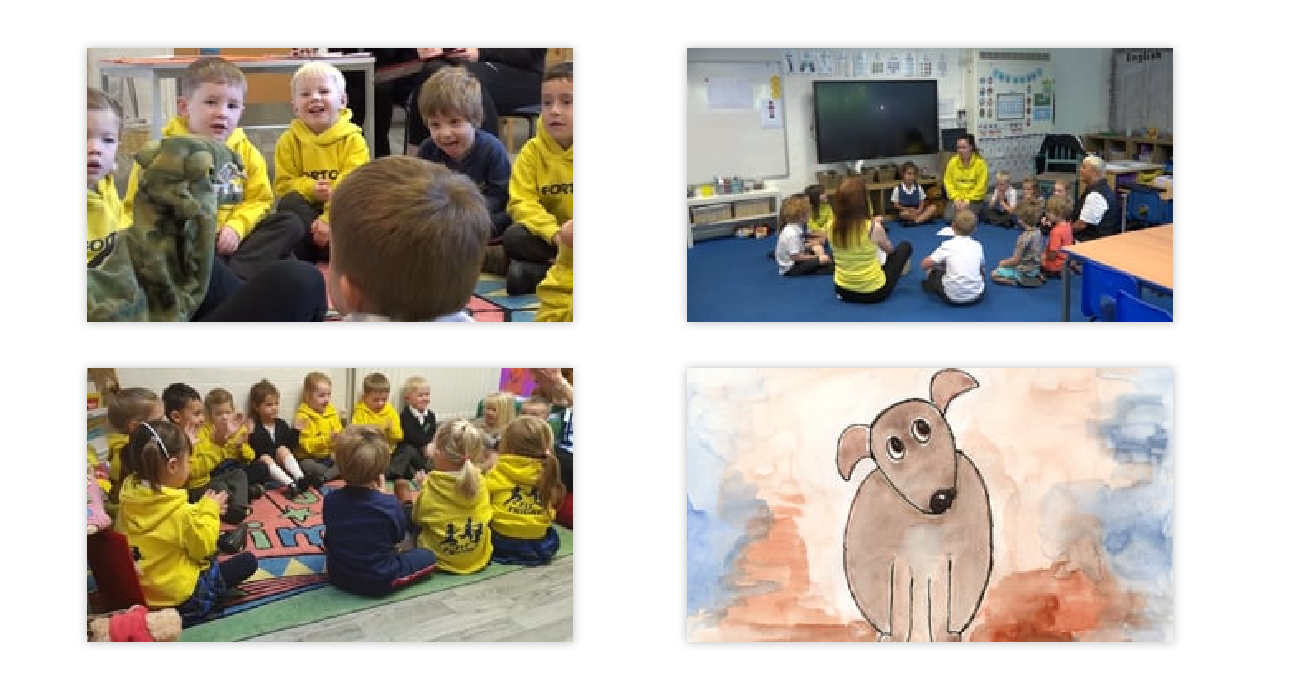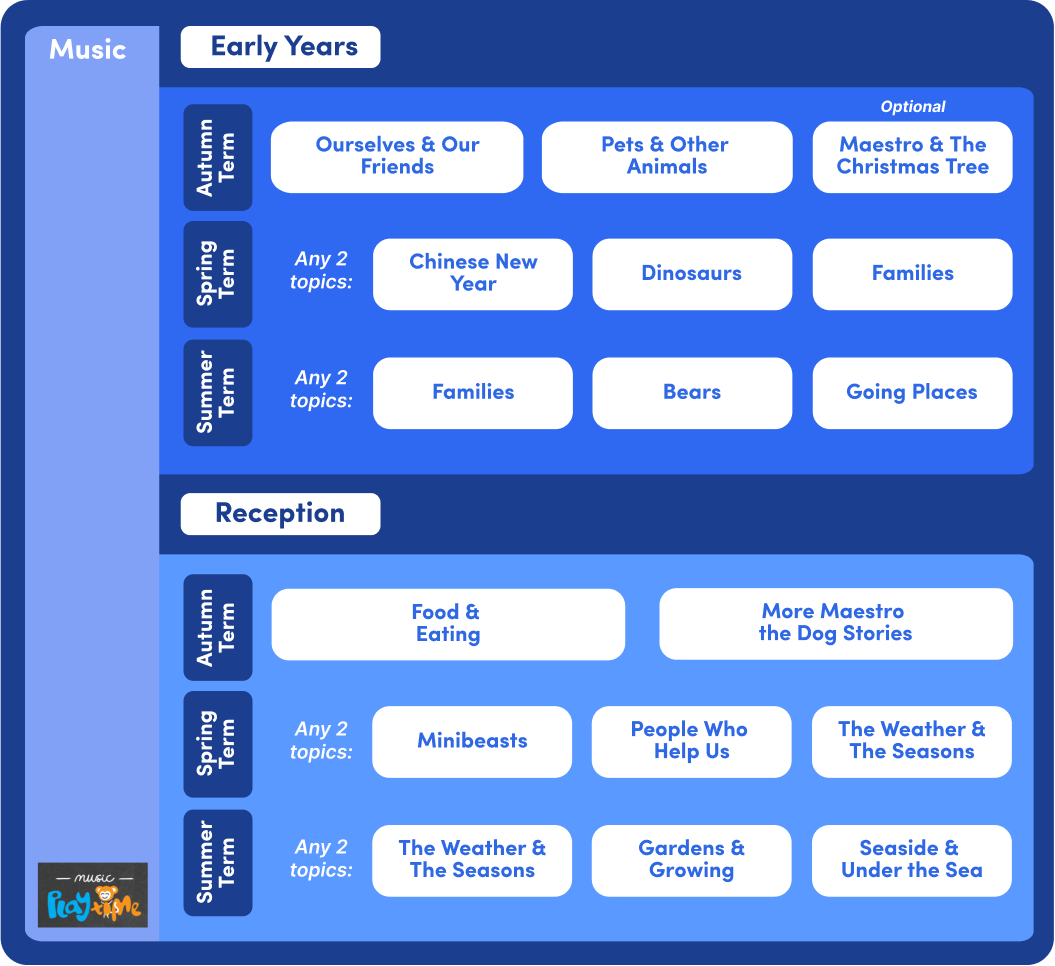Ourselves & Our Friends Level: Early Years

Introducing the Children (and Mrs Crocosaurus!)
Here are the lovely Early Years/Reception children of Forton School who demonstrate, in our videos, how they learned lots of the Music Playtime activities. The videos span a whole school year, three terms, so you'll see different groupings as some children move from Early Years/Reception into Key Stage 1. Several of the children had only just started nursery and we begin with their very first music session.
But who's that green creature? Mrs Crocosaurus is half crocodile and half dinosaur and she comes to help us sing in tune. She likes to hear clear words and she enjoys only beautiful singing! She supervises the accuracy of the singing and the children seem to value her opinion over that of humans!
Introducing your Sing-Song Voice! (pitch)
You will use your sing-song voice in lots of the topics in Music Playtime. It's a kind of initial building block that gives teachers the confidence to start singing and helps the children to begin pitching notes accurately. Sing-song voices are quiet and controlled, teaching the children that beautiful is better than loud.
Learning Names Through Chanting
Spaceships!
Chanting just means speaking rhythmically. Here's a chanting game that will help a new group of children - and you - to learn everyone's name. Children are learning new words every day and soon understand what chanting is if you ask them to join in with their 'chanting voice'. Line the children up, having already put out hula hoops, one per child.
Start by leading the first few children to a hoop as you chant their names in the rhyme. Once the children understand what to do, you can clap in time too. All the children will eventually stand or sit one per hoop.
To put the hoops away, reverse the game and chant, 'Sophie bring your spaceship' (line 1) and 'Harry bring your spaceship' (line 3), and so on.
- Sophie go to your spaceship
- We're going to chant, and say a rhyme
- Harry go to your spaceship
- We're going to chant and clap in time
Meet Luchia, our Music Playtime Singer
Next, I'd like you to meet Luchia Law, the singer on virtually all the sound files. Here she is singing The Wheels on the Bus, which you'll find in the Going Places unit. Most of the songs lend themselves to mime, which you can see Luchia doing here. Mime is great fun, it helps with understanding the meaning and character of a song and the children can do it with, or without, singing the words.
The Wheels on the Bus - Activity
Try asking the children if they think Mrs Crocosaurus would like Luchia's singing. Hopefully, they will say. 'Yes'! If you ask why, you may get the same answer from all the children and it will go something like, 'Because she likes it'. This is fine - little children will almost certainly never have been asked this question before and it gives you the chance to say what you like about it! You could say that Luchia:
- sings the right tune
- uses her singing voice, not her talking voice
- sings not too fast and not too slow
- makes a lovely sound - not shouty and not as quiet as a mouse.
Paired Activities
Music is good for learning how to work with a partner. Children also love to interact musically with an adult, so try to grasp any opportunity to join in with a child who is exploring instruments in the music corner. There is value in modelling a simple activity such as how to 'ting' Indian Bells so that they ring out, and having a child copy you.

Circle Activities
I like to do most music activities sitting on the floor with everyone in a circle. Children of this age are endlessly fascinating because of their phenomenal rate of learning and one of the things I found this group of children needed to learn first was how to sit in a circle! To make it easier, you could first put removable stickers in a circle, to act as place markers.
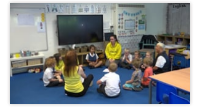
Have You Brought Your Singing Voice? (pitch)
This is a good introductory activity for helping children to 'find' their singing voice and humming voice as opposed to their talking voice. It's one of the first things to do in music with a new group of children. It's also a good attention-grabber to use at any time to settle the children down. Whatever voice the teacher uses, the children copy it when they reply.
- Teacher says: Have you brought your talking voice?
- Children say in a normal talking voice: Yes we have! Yes we have!
- Teacher sing-songs: Have you brought your singing voice?
- Children sing-song: Yes we have! Yes we have!
- Teacher whispers: Have you brought your whispering voice?
- Children whisper: Yes we have! Yes we have!
- Teacher hums: Mm mm mm mm mm mm mm?
- Children hum: Mm mm mm! Mm mm mm!
- And so on ...
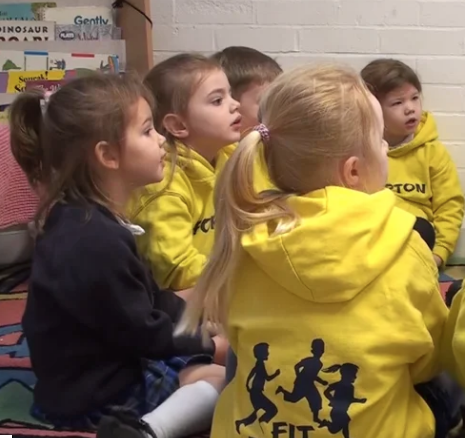
Hickory Dickory Bumble Bee (rhythm)
Ideally, you need a furry bumble bee to help you to indicate which child you are focusing on. When the bumble bee looks at each child in turn, you sing, 'Hickory dickory bumble bee, won't you say your name for me? The child replies by saying their name. It's fun (and good for learning to count sounds) if you ask 'How many claps was that?' after each name is clapped. You can decide in what ways you want the children to copy the name pattern eg talking, humming, clapping, whispering.
- TEACHER - Hickory dickory bumble bee
- Won't you say your name for me?
- CHILD: Edward
- TEACHER: Everyone say it
- CHILDREN: Edward
- TEACHER: Everyone clap it
- CHILDREN: Clap clap
- TEACHER: Everyone whisper it
- CHILDREN: Edward
Getting to Know You
Pat Pat - Names (pulse)
Everyone sits in a circle, cross legged and spaced as widely as is practical. Pat your knees twice, making big movements, and then gesture in a welcoming way towards each child in turn, for just long enough for you to sing-song that child's name. Keep going, round the circle in order, until all the children have been included.
The children join in with patting their knees, in time with you. They could optionally join in with singing each child's name.
- Pat pat
- Arms wide and sing-song Holly
- Pat pat
- Arms wide and sing-song Sophie
The aim is to keep the pulse steady and keep going. If this happens, you can praise the children by saying, 'We're keeping a steady pulse going round the circle - well done!' Children are learning new words all the time and they will pick up meaning of pulse if you use it in context.
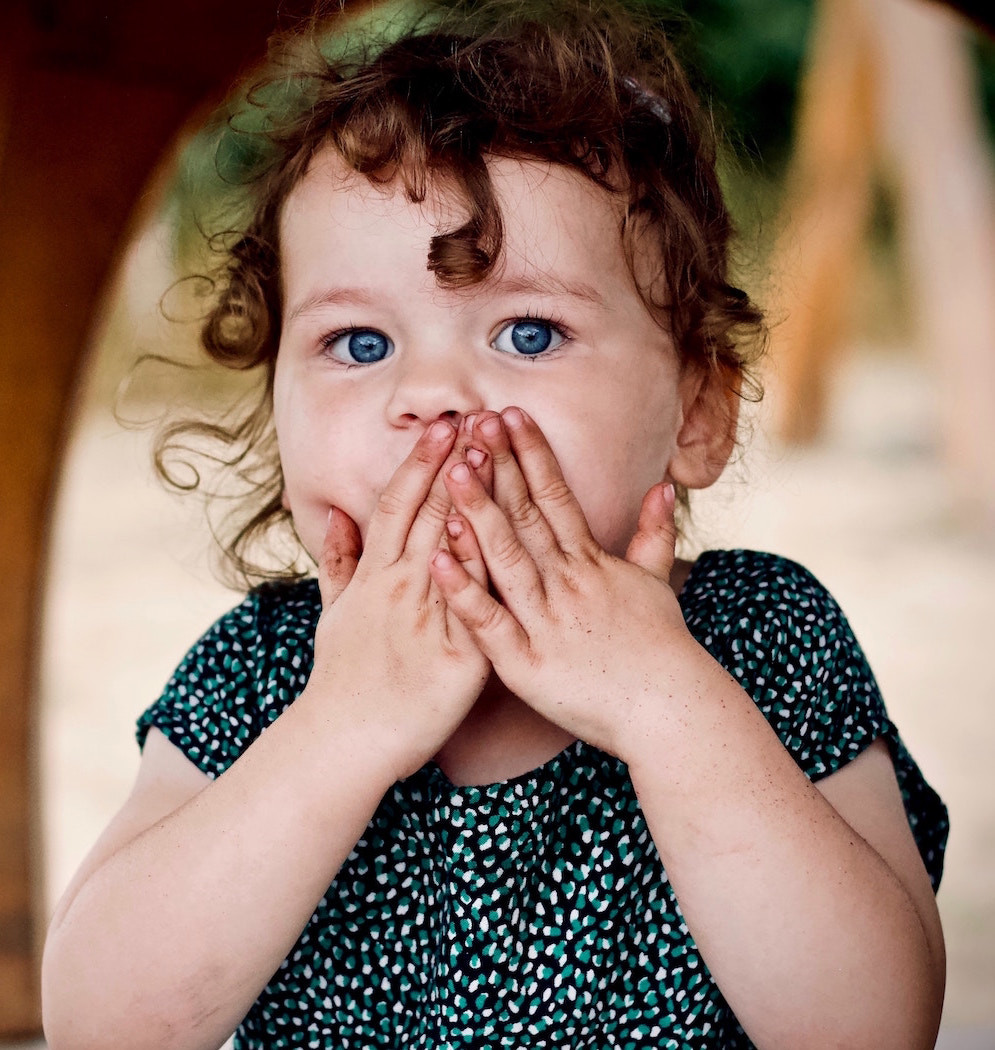
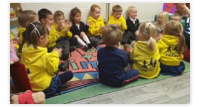
Fast, Slow and Walking! (tempo)
Mrs Crocosaurus helps to explain fast and slow tempo in terms of movement. You can follow this up with singing a song at a fast tempo, and then sing it slowly.
Copy Me (rhythm, pulse)
Using a 'sing-song' voice the teacher sings the first line, Copy me, copy me, clap like me, then claps three times, which the children copy. For subsequent lines, the teacher sings then does something different, which the children copy. The idea is that the teacher does the singing and the children copy the actions, in time with the pulse.
- Copy me, copy me, clap like me
- Copy me, copy me, stamp like me (stay sitting on bottoms)
- Copy me, copy me, tap like me (tap on knees)
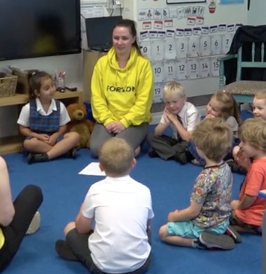
Copy Kitten (pitch, rhythm, timbre)
You need a toy fluffy cat for this game. Begin by asking the children to show you all the sounds they can make using their mouths and voices. Ask them to decide which is their favourite sound and then everyone practise copying each other's sounds.
Next, teach the song with everyone sitting in a circle. Child 1 holds the furry 'Copy Kitten' and makes a sound at the end of the verse for everyone to copy. Child 1 passes Copy Kitten to the second child in the circle; all sing the song again and Child 2 makes a sound for everyone to copy, and so on.
This activity also focuses on timbre, the essential difference between sounds made in different ways.
- Copy kitten, copy kitten
- Miaow miaow hiss
- Copy kitten, copy kitten
- Sounds like this
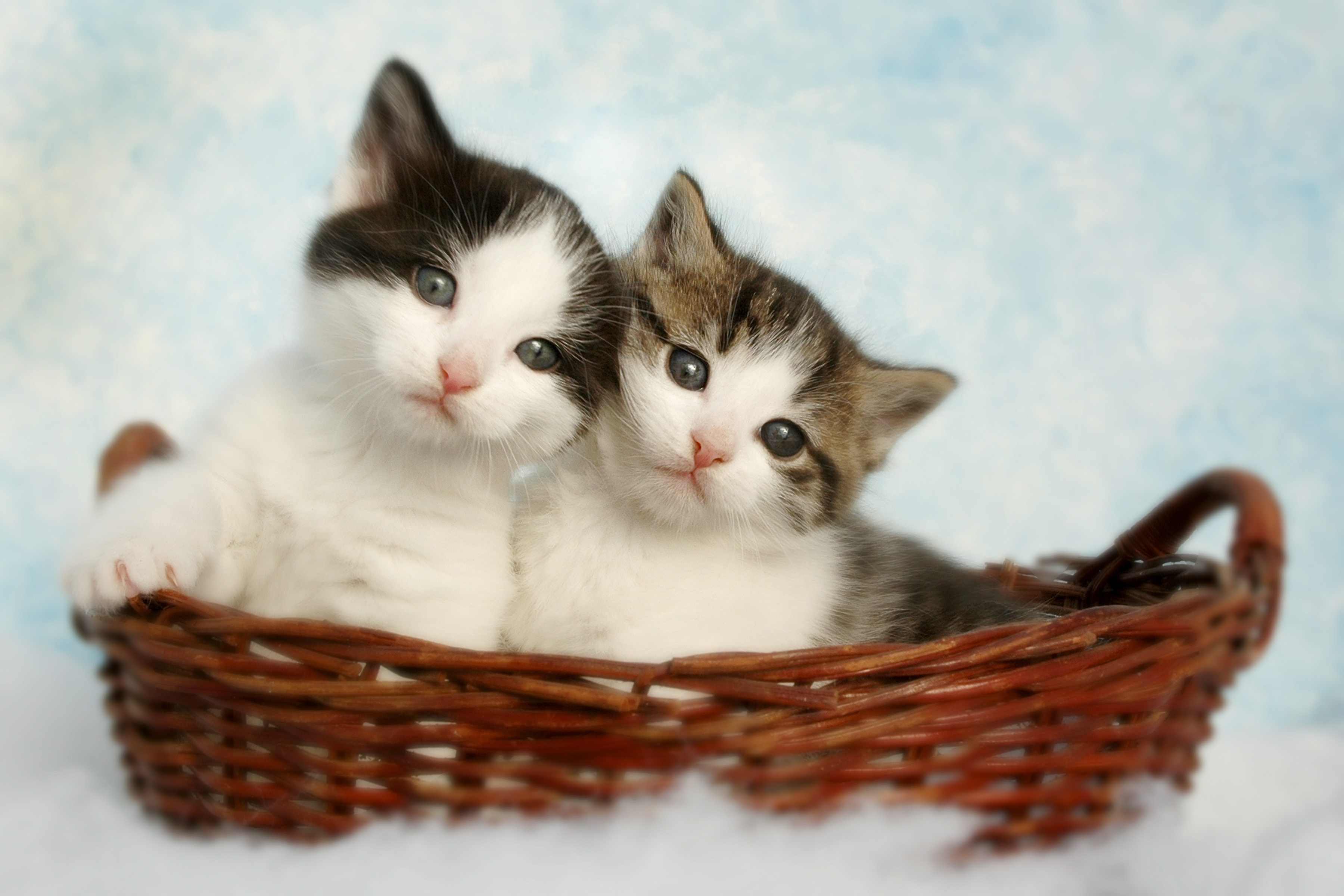
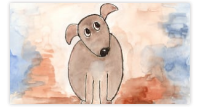
Do you like copying games?
Here's Maestro the Music Dog playing a copying game with his new friend, Coppie the Cat.
- All Maestro the Music Dog materials ©E-MusicMaestroPublishing Limited
- Original watercolours and story: Sandy Holland
- Original music: Peter Noke
Copy Cats
Number Copy Cat (rhythm, dynamics)
Begin with clapping, asking the children to copy you (eg you clap twice - they clap twice, you clap once - they clap once). Then transfer this to other body sounds eg stamping. Next, this can transfer to untuned instruments (eg wood block, shaker), asking the children to copy the way you make the sounds. If they manage this easily, try varying between louder sounds and quieter sounds too (the term for louder/quieter is dynamics).
Name Copy Cat (rhythm)
Model how to clap the rhythm of your own name (eg Fiona = clap clap clap, Miss Jones = clap clap). Next, go round the group in a circle - say, then clap each child's name. The child claps their own name and everyone joins in. The children might notice that several names have the same number of claps.
Untuned instrument Copy Cat (timbre)
This is a music corner activity that needs an adult's help. The idea is to explore the sound (or timbre) of the instruments Put out pairs of the same instruments eg two wood blocks, two drums, two shakers.
First let pairs of children experiment to hear the different sound the instruments make. To introduce the word, timbre in context, you can say, 'The wood block has a different timbre from the drum - listen to how different they sound!' Next see if the children can guess which instrument you play if they cover their eyes.
Help Child 1 to say and play their name (Lyndsay = tap tap) on the wood block. Child 2 copies on the other wood block.
Child 2 says and plays their name on the drum (Jack Fazoli = bang bang bang bang). Child 1 copies on the other drum.
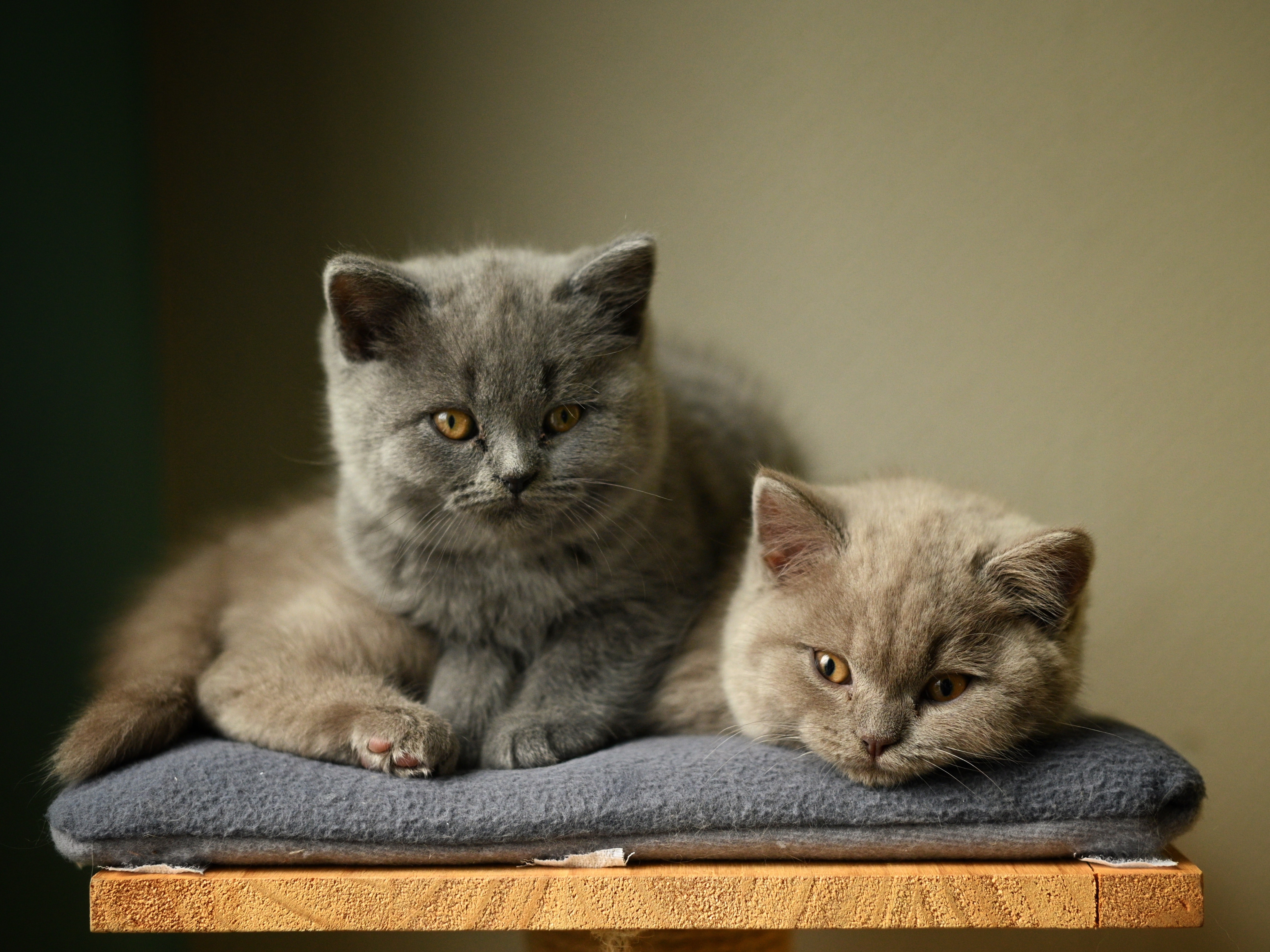
Chime Bar Copy Cat (pitch)
This is a pairs or small group activity, needing an adult. Put out any two different chime bars (C and G OR D and A, so they sound very different) in the music corner. If the chime bars are in a case, it's best to take the two out. First model for the children how to play a chime bar with a beater - the beater needs to bounce off the bar otherwise it will clunk instead of chime!
When the children have their go, it's a great opportunity to say, 'That chime bar has a higher pitch and this one has a lower pitch!' Ask which of the chime bars sounds lower and which sounds higher - the long ones sound lower than the shorter ones. It's important that the children understand that the size makes the difference, not the colour!
1/ Child 1 plays the two chime bars in any order. Child 2 copies what they do. Then swap over.
2/ Child 1 plays the two chime bars in any order. Child 2 covers eyes or turns away then guesses and copies what Child 1 did. Swap over.
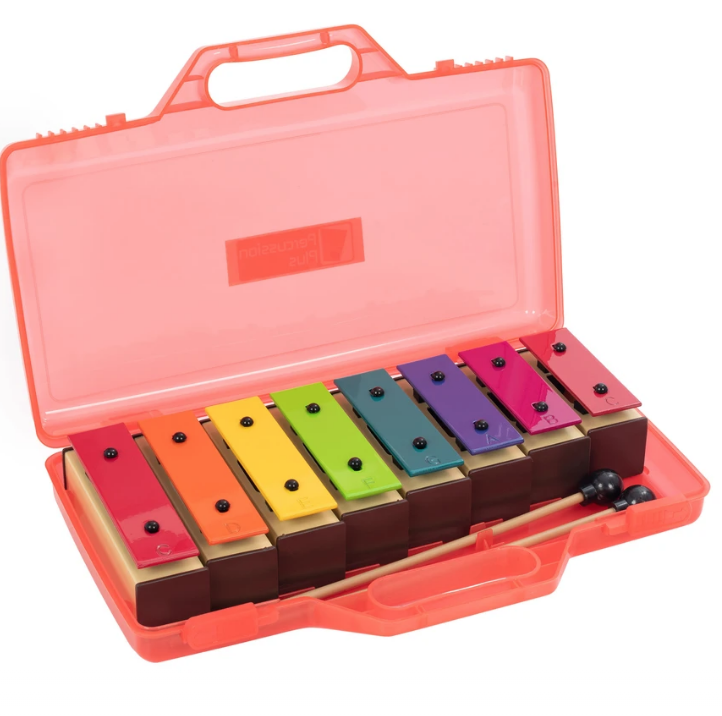
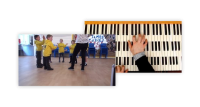
A Dance With Friends! (structure)
Here's a circle dance with different actions that fit with each section of the music, helping to draw attention to the structure of the music. The music is from Rondo Alla Turca by Mozart, the second movement from his piano Sonata in A major. A rondo has a tune that keeps coming back at least three times, interspersed with different tunes, but I have not included the whole movement here, for the sake of simplicity.
When I started teaching this dance I thought the children would never get it, yet after just a few tries they were managing pretty well and loving it! The idea is that doing a different movement to each part of the music helps draw attention to its structure.
Free Dance
After the structured dance, I asked the children to do their own dance and there's an interesting variety of responses. One little boy who had just started nursery was a bit bewildered and walked around but, towards the end you can see one of the older boys (having slid around a bit previously) spontaneously clapping in time with the pulse of the music.
Hide and Seek (tempo)
Ask the children to find one of these things, hidden around the room (hide more objects than children eg 6 white spoons, 3 pink mice, 6 blue beanbags)
For this game, play The Runaway Rocking Horse by Edward White. First the children listen, without moving, to the slow introduction. When the tempo becomes fast, they go and seek. When the music stops they sit down with what they have found.
To put away what they have found, the children listen again to the slow introduction then put the objects away in the right place as the quicker music plays. If the music is still playing, they sit down and watch the video. The music is played on an organ, which is interesting for the children to watch as many will not have seen an organ.
Scary Hide and Seek! (tempo)
The children watch the video of Hide and Seek by Schumann, played on piano, looking out for the eyes peeping from the trees! The could watch again and count how many pairs of eyes they see. Where was the quickest part of the music?
Quick and Slow Sounds (tempo)
Every child needs something that makes a sound - an instrument, a 'found sound' such as a rustly bag, or body sounds eg clapping hands. The teacher is the conductor - when you make big, slow hand movements, the children make slow, smooth sounds and when you make quick, jumpy hand movements they play quickly. Keep changing randomly from one to the other.
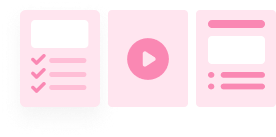
My Hand-print Tree
Use finger paint in a tray. Each child puts the palms of their hands into the paint, then presses them onto a big piece of paper, with their name on, to make six prints. When the paint is dry, cut out the handprints. Each child paints a brown tree-trunk on paper and sticks the prints at the top, like leaves.

A poem and picture about me! (literacy link)
Everyone, including the teachers, make a picture or yourself to show how you look in the mirror!
- In the mirror on the wall
- There’s a face I always see
- Round and pink, and rather small
- Looking back again at me
- It’s very rude to stare
- But she never thinks of that
- For her eyes are always there
- What can she be looking at?

What Would You Like To Be? (PSED Link)
What sort of person would the children like to be? Here's a version of a song that we used to sing in my family when my sister and I were children. I wanted to be a cowboy so that I could ride horses all day and rescue people from danger (I didn't realise it had anything to do with cows or being a boy!) It's an opportunity for the children to talk about what kind of person they want to be when they grow up.
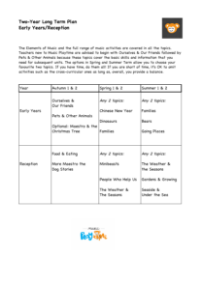
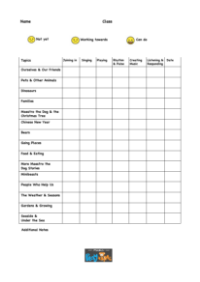
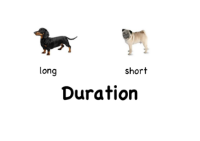
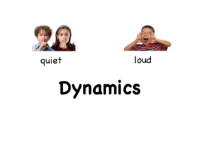
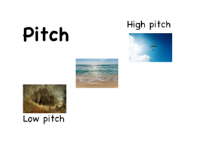
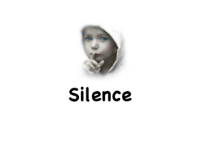
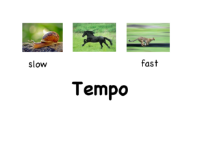
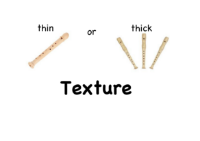
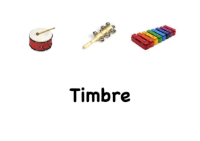

Introducing the Children (and Mrs Crocosaurus!)
Here are the lovely Early Years/Reception children of Forton School who demonstrate, in our videos, how they learned lots of the Music Playtime activities. The videos span a whole school year, three terms, so you'll see different groupings as some children move from Early Years/Reception into Key Stage 1. Several of the children had only just started nursery and we begin with their very first music session.
But who's that green creature? Mrs Crocosaurus is half crocodile and half dinosaur and she comes to help us sing in tune. She likes to hear clear words and she enjoys only beautiful singing! She supervises the accuracy of the singing and the children seem to value her opinion over that of humans!
Introducing your Sing-Song Voice! (pitch)
You will use your sing-song voice in lots of the topics in Music Playtime. It's a kind of initial building block that gives teachers the confidence to start singing and helps the children to begin pitching notes accurately. Sing-song voices are quiet and controlled, teaching the children that beautiful is better than loud.
Learning Names Through Chanting
Spaceships!
Chanting just means speaking rhythmically. Here's a chanting game that will help a new group of children - and you - to learn everyone's name. Children are learning new words every day and soon understand what chanting is if you ask them to join in with their 'chanting voice'. Line the children up, having already put out hula hoops, one per child.
Start by leading the first few children to a hoop as you chant their names in the rhyme. Once the children understand what to do, you can clap in time too. All the children will eventually stand or sit one per hoop.
To put the hoops away, reverse the game and chant, 'Sophie bring your spaceship' (line 1) and 'Harry bring your spaceship' (line 3), and so on.
- Sophie go to your spaceship
- We're going to chant, and say a rhyme
- Harry go to your spaceship
- We're going to chant and clap in time
Meet Luchia, our Music Playtime Singer
Next, I'd like you to meet Luchia Law, the singer on virtually all the sound files. Here she is singing The Wheels on the Bus, which you'll find in the Going Places unit. Most of the songs lend themselves to mime, which you can see Luchia doing here. Mime is great fun, it helps with understanding the meaning and character of a song and the children can do it with, or without, singing the words.
The Wheels on the Bus - Activity
Try asking the children if they think Mrs Crocosaurus would like Luchia's singing. Hopefully, they will say. 'Yes'! If you ask why, you may get the same answer from all the children and it will go something like, 'Because she likes it'. This is fine - little children will almost certainly never have been asked this question before and it gives you the chance to say what you like about it! You could say that Luchia:
- sings the right tune
- uses her singing voice, not her talking voice
- sings not too fast and not too slow
- makes a lovely sound - not shouty and not as quiet as a mouse.
Paired Activities
Music is good for learning how to work with a partner. Children also love to interact musically with an adult, so try to grasp any opportunity to join in with a child who is exploring instruments in the music corner. There is value in modelling a simple activity such as how to 'ting' Indian Bells so that they ring out, and having a child copy you.

Circle Activities
I like to do most music activities sitting on the floor with everyone in a circle. Children of this age are endlessly fascinating because of their phenomenal rate of learning and one of the things I found this group of children needed to learn first was how to sit in a circle! To make it easier, you could first put removable stickers in a circle, to act as place markers.

Have You Brought Your Singing Voice? (pitch)
This is a good introductory activity for helping children to 'find' their singing voice and humming voice as opposed to their talking voice. It's one of the first things to do in music with a new group of children. It's also a good attention-grabber to use at any time to settle the children down. Whatever voice the teacher uses, the children copy it when they reply.
- Teacher says: Have you brought your talking voice?
- Children say in a normal talking voice: Yes we have! Yes we have!
- Teacher sing-songs: Have you brought your singing voice?
- Children sing-song: Yes we have! Yes we have!
- Teacher whispers: Have you brought your whispering voice?
- Children whisper: Yes we have! Yes we have!
- Teacher hums: Mm mm mm mm mm mm mm?
- Children hum: Mm mm mm! Mm mm mm!
- And so on ...

Hickory Dickory Bumble Bee (rhythm)
Ideally, you need a furry bumble bee to help you to indicate which child you are focusing on. When the bumble bee looks at each child in turn, you sing, 'Hickory dickory bumble bee, won't you say your name for me? The child replies by saying their name. It's fun (and good for learning to count sounds) if you ask 'How many claps was that?' after each name is clapped. You can decide in what ways you want the children to copy the name pattern eg talking, humming, clapping, whispering.
- TEACHER - Hickory dickory bumble bee
- Won't you say your name for me?
- CHILD: Edward
- TEACHER: Everyone say it
- CHILDREN: Edward
- TEACHER: Everyone clap it
- CHILDREN: Clap clap
- TEACHER: Everyone whisper it
- CHILDREN: Edward
Getting to Know You
Pat Pat - Names (pulse)
Everyone sits in a circle, cross legged and spaced as widely as is practical. Pat your knees twice, making big movements, and then gesture in a welcoming way towards each child in turn, for just long enough for you to sing-song that child's name. Keep going, round the circle in order, until all the children have been included.
The children join in with patting their knees, in time with you. They could optionally join in with singing each child's name.
- Pat pat
- Arms wide and sing-song Holly
- Pat pat
- Arms wide and sing-song Sophie
The aim is to keep the pulse steady and keep going. If this happens, you can praise the children by saying, 'We're keeping a steady pulse going round the circle - well done!' Children are learning new words all the time and they will pick up meaning of pulse if you use it in context.


Fast, Slow and Walking! (tempo)
Mrs Crocosaurus helps to explain fast and slow tempo in terms of movement. You can follow this up with singing a song at a fast tempo, and then sing it slowly.
Copy Me (rhythm, pulse)
Using a 'sing-song' voice the teacher sings the first line, Copy me, copy me, clap like me, then claps three times, which the children copy. For subsequent lines, the teacher sings then does something different, which the children copy. The idea is that the teacher does the singing and the children copy the actions, in time with the pulse.
- Copy me, copy me, clap like me
- Copy me, copy me, stamp like me (stay sitting on bottoms)
- Copy me, copy me, tap like me (tap on knees)

Copy Kitten (pitch, rhythm, timbre)
You need a toy fluffy cat for this game. Begin by asking the children to show you all the sounds they can make using their mouths and voices. Ask them to decide which is their favourite sound and then everyone practise copying each other's sounds.
Next, teach the song with everyone sitting in a circle. Child 1 holds the furry 'Copy Kitten' and makes a sound at the end of the verse for everyone to copy. Child 1 passes Copy Kitten to the second child in the circle; all sing the song again and Child 2 makes a sound for everyone to copy, and so on.
This activity also focuses on timbre, the essential difference between sounds made in different ways.
- Copy kitten, copy kitten
- Miaow miaow hiss
- Copy kitten, copy kitten
- Sounds like this


Do you like copying games?
Here's Maestro the Music Dog playing a copying game with his new friend, Coppie the Cat.
- All Maestro the Music Dog materials ©E-MusicMaestroPublishing Limited
- Original watercolours and story: Sandy Holland
- Original music: Peter Noke
Copy Cats
Number Copy Cat (rhythm, dynamics)
Begin with clapping, asking the children to copy you (eg you clap twice - they clap twice, you clap once - they clap once). Then transfer this to other body sounds eg stamping. Next, this can transfer to untuned instruments (eg wood block, shaker), asking the children to copy the way you make the sounds. If they manage this easily, try varying between louder sounds and quieter sounds too (the term for louder/quieter is dynamics).
Name Copy Cat (rhythm)
Model how to clap the rhythm of your own name (eg Fiona = clap clap clap, Miss Jones = clap clap). Next, go round the group in a circle - say, then clap each child's name. The child claps their own name and everyone joins in. The children might notice that several names have the same number of claps.
Untuned instrument Copy Cat (timbre)
This is a music corner activity that needs an adult's help. The idea is to explore the sound (or timbre) of the instruments Put out pairs of the same instruments eg two wood blocks, two drums, two shakers.
First let pairs of children experiment to hear the different sound the instruments make. To introduce the word, timbre in context, you can say, 'The wood block has a different timbre from the drum - listen to how different they sound!' Next see if the children can guess which instrument you play if they cover their eyes.
Help Child 1 to say and play their name (Lyndsay = tap tap) on the wood block. Child 2 copies on the other wood block.
Child 2 says and plays their name on the drum (Jack Fazoli = bang bang bang bang). Child 1 copies on the other drum.

Chime Bar Copy Cat (pitch)
This is a pairs or small group activity, needing an adult. Put out any two different chime bars (C and G OR D and A, so they sound very different) in the music corner. If the chime bars are in a case, it's best to take the two out. First model for the children how to play a chime bar with a beater - the beater needs to bounce off the bar otherwise it will clunk instead of chime!
When the children have their go, it's a great opportunity to say, 'That chime bar has a higher pitch and this one has a lower pitch!' Ask which of the chime bars sounds lower and which sounds higher - the long ones sound lower than the shorter ones. It's important that the children understand that the size makes the difference, not the colour!
1/ Child 1 plays the two chime bars in any order. Child 2 copies what they do. Then swap over.
2/ Child 1 plays the two chime bars in any order. Child 2 covers eyes or turns away then guesses and copies what Child 1 did. Swap over.


A Dance With Friends! (structure)
Here's a circle dance with different actions that fit with each section of the music, helping to draw attention to the structure of the music. The music is from Rondo Alla Turca by Mozart, the second movement from his piano Sonata in A major. A rondo has a tune that keeps coming back at least three times, interspersed with different tunes, but I have not included the whole movement here, for the sake of simplicity.
When I started teaching this dance I thought the children would never get it, yet after just a few tries they were managing pretty well and loving it! The idea is that doing a different movement to each part of the music helps draw attention to its structure.
Free Dance
After the structured dance, I asked the children to do their own dance and there's an interesting variety of responses. One little boy who had just started nursery was a bit bewildered and walked around but, towards the end you can see one of the older boys (having slid around a bit previously) spontaneously clapping in time with the pulse of the music.
Hide and Seek (tempo)
Ask the children to find one of these things, hidden around the room (hide more objects than children eg 6 white spoons, 3 pink mice, 6 blue beanbags)
For this game, play The Runaway Rocking Horse by Edward White. First the children listen, without moving, to the slow introduction. When the tempo becomes fast, they go and seek. When the music stops they sit down with what they have found.
To put away what they have found, the children listen again to the slow introduction then put the objects away in the right place as the quicker music plays. If the music is still playing, they sit down and watch the video. The music is played on an organ, which is interesting for the children to watch as many will not have seen an organ.
Scary Hide and Seek! (tempo)
The children watch the video of Hide and Seek by Schumann, played on piano, looking out for the eyes peeping from the trees! The could watch again and count how many pairs of eyes they see. Where was the quickest part of the music?
Quick and Slow Sounds (tempo)
Every child needs something that makes a sound - an instrument, a 'found sound' such as a rustly bag, or body sounds eg clapping hands. The teacher is the conductor - when you make big, slow hand movements, the children make slow, smooth sounds and when you make quick, jumpy hand movements they play quickly. Keep changing randomly from one to the other.

My Hand-print Tree
Use finger paint in a tray. Each child puts the palms of their hands into the paint, then presses them onto a big piece of paper, with their name on, to make six prints. When the paint is dry, cut out the handprints. Each child paints a brown tree-trunk on paper and sticks the prints at the top, like leaves.

A poem and picture about me! (literacy link)
Everyone, including the teachers, make a picture or yourself to show how you look in the mirror!
- In the mirror on the wall
- There’s a face I always see
- Round and pink, and rather small
- Looking back again at me
- It’s very rude to stare
- But she never thinks of that
- For her eyes are always there
- What can she be looking at?

What Would You Like To Be? (PSED Link)
What sort of person would the children like to be? Here's a version of a song that we used to sing in my family when my sister and I were children. I wanted to be a cowboy so that I could ride horses all day and rescue people from danger (I didn't realise it had anything to do with cows or being a boy!) It's an opportunity for the children to talk about what kind of person they want to be when they grow up.











